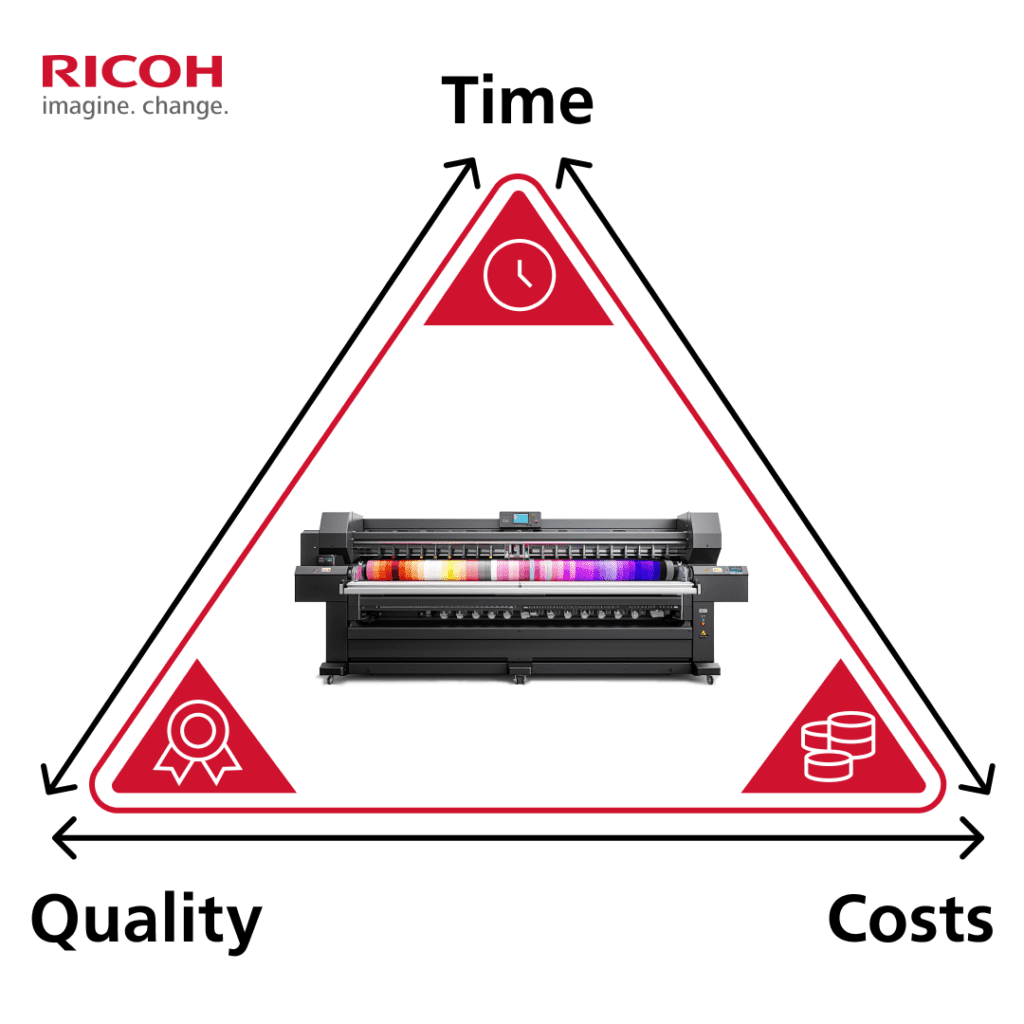Commercial printers operate in a demanding business landscape. They must constantly strive to deliver high-quality products quickly and affordably. Clients want it all: fast turnarounds, exceptional quality, and competitive pricing. Balancing these competing priorities can often feel overwhelming.
To gain a fresh perspective on this challenge, we sat down with Erwin Busselot, an industry veteran with extensive experience in digital printing. As the Business Innovation and Solutions Director at Ricoh Europe, Erwin brings a deep understanding of the evolving needs of commercial printers and the technological advancements driving the industry forward.
“It’s about moving beyond the simple equation of short runs and break-even points,” Erwin explains. “Today, it’s about understanding how to leverage digital printing technologies to deliver both quality and time.”
In this insightful conversation, Erwin sheds light on:
- What the TQC triangle is and how it can be used to improve print operations.
- How a deep understanding of the TQC triangle can help printers make strategic, profitable decisions.
- How printers can find the right balance between time, cost, and quality.
Keep reading to explore actionable strategies for conquering the complexities of short-run printing, unlocking new levels of efficiency and profitability for your business.
Defining the TQC Triangle
The TQC triangle provides a simple yet powerful framework for understanding the interconnected nature of time, quality, and cost in printing. Erwin explains this concept using a memorable analogy: “Imagine a military tank,” he says. “It has three basic features: mobility, firepower, and armor. And you can never have all three at their maximum.”
Just like a tank must balance these competing needs, a successful printing operation relies on finding the right equilibrium between time, quality, and cost.
The 3 Sides of the TQC Triangle
Time
Clients expect projects to be completed quickly, and the printing industry has had to adapt to these shrinking deadlines. Erwin notes a significant shift in turnaround times: “When I started in graphic arts, the lead time for a print job was two weeks. Today, it’s less than 48 hours. And in many cases, even 24 hours.”
To remain competitive, printers need technologies that can keep pace with these demands. Solutions like continuous feed inkjet press offer the speed and efficiency required for high-volume, fast-turnaround printing. Advanced inkjet presses allow print service providers to meet client deadlines without compromising on other aspects of the TQC triangle.
2. Quality
Even with tight deadlines, quality cannot be overlooked. A high-quality print job, characterized by sharp details, vibrant colors, and a professional finish, enhances brand perception and conveys a sense of value. Erwin emphasizes this point using the example of a photo album printer that relies on Ricoh’s digital presses to maintain exceptional quality standards, even during peak seasons when speed is critical.
3. Cost
Printers face constant pressure to control costs. Factors like rising paper prices, a challenge highlighted by Erwin, make cost management even more crucial. However, true cost-effectiveness extends beyond just the price-per-print.
Streamlining workflows to minimize waste and errors is key to long-term cost savings. As Erwin puts it, “If I look at the flexibility that the digital press offers me to balance my full production… that is more worthwhile than to be the cheapest on the cost of the print.”
Ricoh offers a suite of workflow automation solutions, including Ricoh TotalFlow Prep, which helps printers optimize their entire production process. By reducing waste and improving efficiency, printers can achieve significant cost savings while delivering high-quality prints on time.
Finding Balance
Understanding the TQC triangle is not about maximizing all three elements simultaneously — it’s about recognizing that trade-offs are inevitable. The ideal balance between time, quality, and cost will differ for every print job.
For example, a client with a tight deadline might be willing to sacrifice some level of quality for speed and cost-effectiveness. Conversely, a project requiring premium materials and intricate finishing techniques will likely demand more time and a higher budget.
As Erwin explains, “When you listen to a customer and your customer says, ‘If only I could…’ then you should listen very carefully and note what he’s saying and try to do that because then you might manage to have the triangle with the three parts.”
Ricoh understands that finding the right balance requires a collaborative approach. Its commitment to co-innovation means working closely with printers to understand their specific needs and develop solutions that address their unique challenges. This might involve helping printers implement new technologies, optimize workflows, or develop new marketing strategies to target specific client segments.
Mastering the TQC Triangle for Printing Success
As Erwin’s insights demonstrate, the key to thriving in a competitive printing landscape lies in understanding and mastering the TQC triangle. By strategically balancing time, quality, and cost considerations, print service providers can meet evolving client expectations, optimize their operations, and unlock new levels of profitability.
Ricoh, with its range of innovative digital printing solutions and commitment to co-innovation, is a valuable partner for printers seeking to navigate these complexities and find the optimal balance within the TQC triangle.
Ready to take your printing operation to the next level? Contact Ricoh today to explore our comprehensive range of solutions and discover how we can help you achieve your business goals.
Back to All Blogs
Contact Us
Contact form on the bottom of all pages


